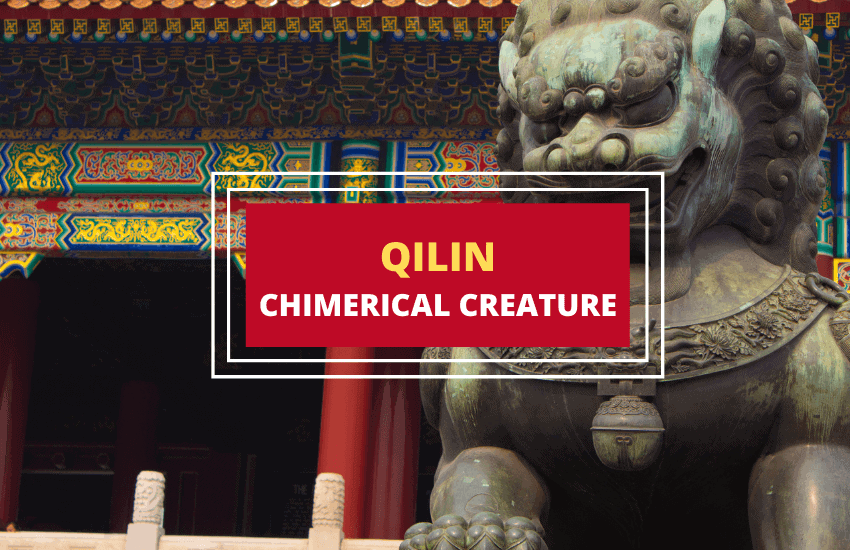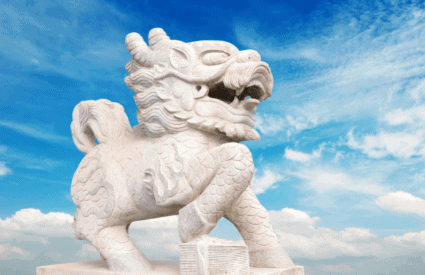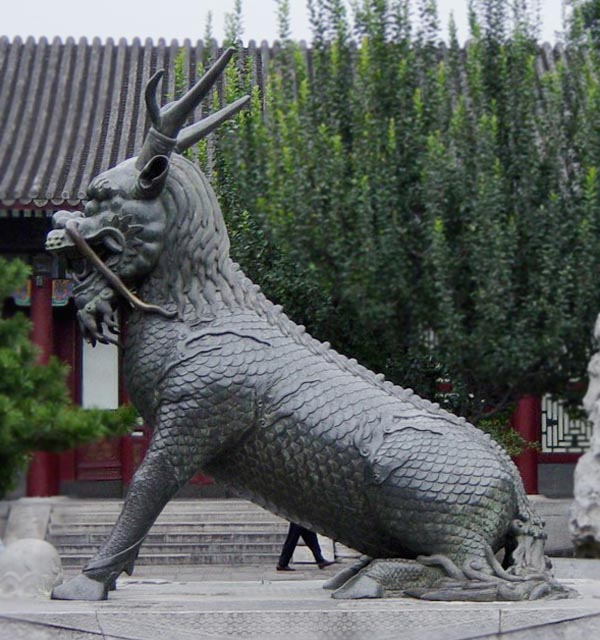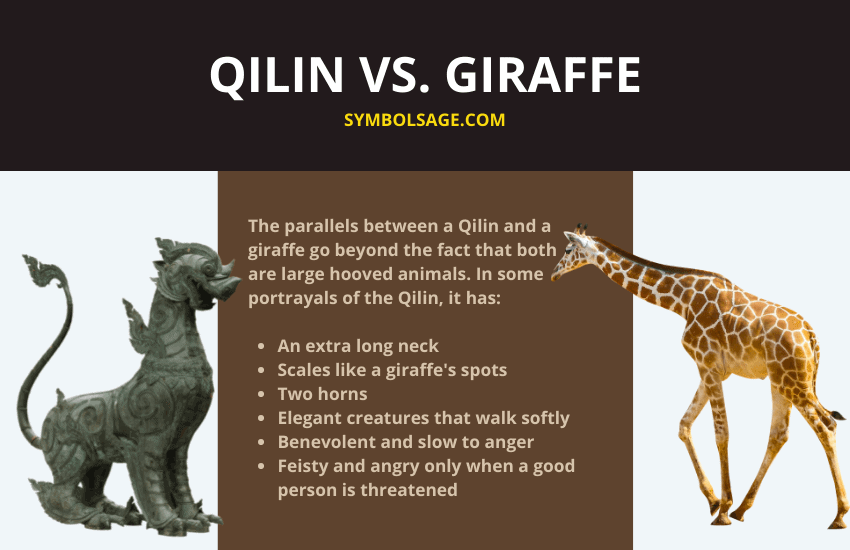
Table of Contents
A beast of many names, the Qilin is also known as a Chi-lin, Kirin, Gilen, and more. This mythical creature has even more different physical descriptions, which is not surprising given that the Qilin has been a part of Chinese mythology for over 4,000 years. The Qilin is one of the four most significant Chinese mythical beasts together with the Dragon, Phoenix, and the Tortoise but it’s arguably the least well-known of the four in western countries.
What is a Qilin?

A unicorn, a giraffe, a dragon-horse – the Qilin can be identified in many different ways. And, indeed, different Chinese ethnic cultures and myths portray the beast in various ways. Some say that the Qilin has scales, others that it has a dragon head with two horns in it.
Others yet claim that it has a single horn on its head, similar to a Western unicorn. In some myths, the Qilin has an elongated neck and in others a lizard-like ridge on its back.
To properly identify every different iteration of the Qilin we’d need to write an entire library and not just an article, but we can at least go over the basics.

What Makes the Qilin Unique?
The Qilin is a very special mythical beast in Chinese mythology in that it’s perfectly good and benevolent. Most creatures in Chinese myths are morally ambiguous or grey. They can be both good and evil, while some are downright malevolent.
Not the Qilin.
This mythical beast is viewed almost in the same way as a Western unicorn – perfectly good, grass-eating, gentle, beautiful, and very seclusive. A Qilin would appear or allow itself to be seen very rarely, perhaps only once every several generations.
It would usually come out of its secret enclave when someone is in danger, when something good has happened such as the birth of a great ruler, or other key historic events. The Qilin are also said to be perfectly just and to be able to assess a man’s character by just looking at him. That’s why Qilin statues are usually placed in court buildings and not just temples and places of worship, as a symbol of justice.
It’s very rarely that a Qilin would get angry and attack someone but when it does it’s always against an evil person who has done, or is about to do, something awful. That’s why the Qilin is also viewed as a defender of the righteous and there are many Qiling statues around the royal palaces of China.
The First Qilin
The earliest references to the Qilin we have date back to the 5th century BCE in the Zuo Zhuan Chinese historic chronicles. However, the historic speculation is that the first time an actual Qilin appeared in China was during the time of the legendary Yellow Emperor Huangdi in 2697 BCE – over 4,700 years ago.
Many historians associate such myths with stories of the first giraffes ever to be brought to Chinese rulers. There are no native giraffes in China, of course, but there’s evidence that traveling animal traders or explorers would sometimes make the journey from North-East Africa to the Far East.
One such example fares back to the Ming dynasty when the explorer Zheng He brought a giraffe from Somalia in front of the Chinese Emperor. Given that emperors before that were also likely brought giraffes, it stands to reason that the Qilin might be modeled after this exotic animal. However, what are the actual similarities between the two?
The Qilin and Giraffes
The parallels between a Qilin and a giraffe go beyond the fact that both are large hooved animals. Here are some things to note:
- Historic evidence suggests that the Chinese people knew of giraffes but viewed them as mysterious animals as they’d only see one every few centuries.
- Qilin are said to appear in China very rarely – only on specific occasions such as the birth or death of a ruler. This fits with the fact that giraffes were only brought in front of the Chinese court by travelers and explorers as entertainment for certain events.
- Most older variants of the Qilin portray the beast with two horns coming off the back of its head. This is similar to giraffes who have two small horns too.
- The Qilin are often portrayed with scales. While giraffes have hair instead, their coats have a spotty pattern. So, when the Chinese descriptions of the giraffe were passed on from one generation to the next, it’s easy to imagine the spots becoming scales.
- The Qilin are usually described as benevolent and elegant creatures. Many myths say that they step so softly on the ground that they are even careful not to step on insects or break the grass blades they walked on. This is similar to giraffes in that they are also peaceful vegetarians. Furthermore, their long legs give them a rather elegant and careful walk.
- Many Qilin pictures portray them with extra long necks.
- The only myths that portray Qilin as angry or feisty are myths in which a good person is threatened and in need of defense. This is in line with the behavior of most giraffes who would stray away from conflict until someone in the herd is threatened upon which they can become furious and deadly.

The Qiling and Unicorns
Qilin are famous as “Chinese unicorns”. This is somewhat understandable given the similarities between the two. Both Qiling and unicorns are peaceful, grass-eating, benevolent, seclusive, and hooved mythical animals. Some Qilin are also portrayed with a single horn on their head.
At the same time, however, there are a lot of major differences between the two. For one, a Qilin looks almost nothing like a Western unicorn. The Qilin usually has scales, a dragon-like head, as well as two elk-like horns on the back of its head. During the Jin dynasty, Qilins were even depicted as wreathed in fire and smoke, similar to a dragon and not a unicorn.
What’s more, there is already a word for “one-horned beast” in Chinese and it’s not Qilin but Dújiǎoshòu. This term exists because there are a number of other one-horned beasts in Chinese mythology. And, whenever a Qilin is depicted with a single horn, it’s usually given the separate designation of “one-horned Qilin” and not just a Qilin.
Nevertheless, the people in China eventually noticed how quick Westerners were to associate the Qilin with unicorns. The Chinese government and artists have started playing into that idea and there are more and more pieces of art portraying more unicorn-like Qilin. There are even minted platinum, gold, and silver coins portraying unicorn Qilin.
Symbols and Symbolism of the Qilin
Qilin is one of the most beloved Chinese mythological beasts. It’s viewed as a magical protector of the people and the law, a symbol of good luck, a bringer of prosperity, as well as success and longevity, and much more.
Qilin are even often portrayed as symbols of fertility that bring people their newborn babies the same way storks do in western culture. In essence, the Qilin represents almost everything we view as good and just.
Importance of Qilin in Modern Culture
Qilin may not be as famous abroad as the dragon, phoenix, or the tortoise but they’ve still made their way into quite a few works of fiction and pop culture.
Some examples include the 47 Ronin movie, the famous Monster Hunter video game as well as the Final Fantasy game franchise, and the Dungeons & Dragons RPG universe.
There’s also The Twelve Kingdoms anime series, Takashi Miike’s 2005 The Great Yokai War fantasy film, and even the My Little Pony: Friendship Is Magic children’s animation.
Wrapping Up
There is no consensus on what exactly the qilin is or looks like. However, most accounts agree that it’s a benevolent, kind creature that appears on special occasions. Like the Western unicorn, the Chinese qilin is beloved and respected.








